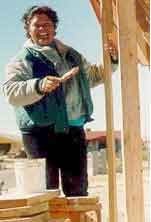_r1_c1.gif)
_r1_c2.gif)
_r1_c1.gif) |
_r1_c2.gif) |
|
Calvert Foundation:
|
|---|
 |
The Calvert Social Investment Foundation offers several community investment options for banks that can transform your capital into economic opportunities for those who need it the most. The Calvert Foundation's broad objective is to create "community investment" as a new asset class in the financial services industry. In addition, CF recently began offering investors the option to register and exchange their investments electronically through the Depository Trust Corporation, thus making the process faster and easier.
Much like a real world matchmaker, CF solves challenges faced by both bank investors and nonprofit borrowers. Banks without the resources to find quality CRA investments can look to CF to prescreen nonprofits for financial and operational capability and to monitor investments over time. Although CF's Community Investment Notes--a financial instrument designed to pay a fixed, below-market rate of interest for the term of the note--are not federally insured, the risk is mitigated in a number of other ways. Enhancements include portfolio diversification, rigorous due diligence, and portfolio monitoring. Community nonprofits that pass the CF screening process gain access to financing for community-based initiatives, including affordable housing, microcredit, small business financing, and social enterprise programs. With Calvert Foundation bridging the gap to bring the two parties together, many happy investment "unions" are happening. To date, CF has matched over 2,100 investors with over 150 borrowers. CF's portfolio currently stands at about $73 million.
When doing community lending, banks like to place their funds locally. Calvert Foundation can find compatible nonprofits. A bank committed to a minimum $50,000 investment in a CIN can ask Calvert Foundation to search for nonprofits in the bank's CRA assessment area (or broader regional area) to locate a good match. CF can match investments to the bank's criteria, and it has different ways to meet the bank's criteria, including a direct investment in a project or a loan to a qualified financial intermediary.
|
Just like a matchmaker checks into family history, CF conducts due diligence seeking investments that are diversified and well managed. The Foundation has ten years of experience in community development lending and a low loss ratio.
The Calvert Foundation raised over $80 million through the sale of CINs. The funds serve as the source of capital for the loans made to qualifying entities. The purchaser of the CIN chooses the interest rate of return, ranging from 0 percent to 2 percent for investment terms of 1 to 3 years, and 0 percent to 3 percent for investment terms of 5 to 10 years. The CINs, in turn, enable CF to lend to community development financial institutions and affordable housing developers at 4 percent to 4.5 percent. Such below-market interest rates and flexible terms make these loans attractive to nonprofits providing products for low- and moderate-income people and organizations serving this population. In addition, CF recently began offering investors the option to register and exchange their investments electronically through the Depository Trust Corporation, thus making the process faster and easier.
CF also works with nonprofits to meet their specific needs when possible. One of its largest loans to date is a $1 million unsecured loan to BRIDGE Housing Corp., San Francisco. As one of California's largest nonprofit developers, BRIDGE turned to Calvert Foundation when it needed money for a pre-development pool of funds. Like many nonprofit developers, BRIDGE found it difficult to create a dedicated pool of seed money for planning projects, given that it works at break-even levels and has no excess earnings to dedicate to such use. The CF loan to BRIDGE gave the nonprofit the funding needed to plan, acquire, and develop projects like Sycamore Place. As the projects are built, the pre-development financing is "taken out" with traditional financing, thus replenishing the seed pool (see sidebar, below, for a description of a BRIDGE housing project).
|
In another investment, CF and a number of smaller Los Angeles banks are piloting a program that combines the Community Investment Note program with an equity equivalent investment or EQ2. The banks will each make a $10,000 EQ2 (subordinated loan) and purchase a $90,000 community investment note. Calvert Foundation pools these funds, resulting in a blended interest rate that makes CF's loans more affordable to nonprofits. CF's pilot program is intended to reduce borrowing costs for qualifying nonprofits. Investments or loans to CF may be eligible to receive positive consideration under the CRA (see the CRA regulation and Interagency Questions and Answers for details).
In New Iberia, Louisiana, CF's matchmaking efforts have provided capital to the Southern Mutual Help Association, Inc. (SMHA). That capital is helping local dreams come true for people like Darlene Carpenter, who only imagined a home of her own six years ago (see sidebar, below, for a profile of an SMHA borrower). SMHA works in poor, rural communities of southern Louisiana, like New Iberia, to help local residents build assets and create new wealth in their communities. Founded in 1969, Southern Mutual Help Association (SMHA) focuses on economic development in distressed rural Louisiana communities, primarily working with agricultural and pervasively poor communities, women and people of color. SMHA helps build rural communities through people's growth in their own empowerment and the just management of resources. SMHA works in two areas: Building Rural Communities and Life Quality. All are programs designed to help people help themselves by providing a means to enter the economic mainstream.
|
As it moves forward, Calvert Foundation believes that it has developed an effective way for investors to reach the nonprofit-community development sector with targeted bank investments. In addition, CF provides double bottom line results through a financial return to the investor and community benefits.
For further information about the Calvert Social Investment Foundation, visit http://www.calvertfoundation.org or contact Shari Berenbach, executive director, at (800) 248-0337.